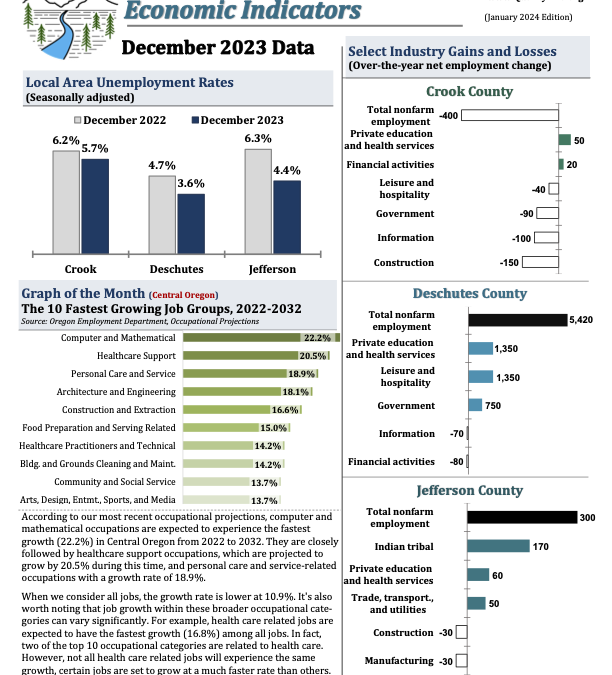Economy in Central Oregon
By Nicole Ramos | Regional Economist, East Cascades | Oregon Employment Department
In terms of employment changes, Jefferson County experienced a year-over-year increase of 300 jobs. In contrast, Crook County observed a decrease in total nonfarm payroll employment by 400 jobs during the same period. On the other hand, Deschutes County exhibited significant growth, with employment increasing by 5,420 jobs year-over-year.
The nation’s seasonally adjusted unemployment rate was 3.7% in December, unchanged from November’s rate. At the statewide level, there was a slight increase in the unemployment rate from 3.6% in November to 3.7% in December, now aligning with the nation’s unemployment rate.
Throughout November and December, the seasonally adjusted unemployment rates across Central Oregon remained unchanged. Deschutes County sustained an unemployment rate of 3.6%, Jefferson County maintained a rate of 4.4%, and Crook County held steady at 5.7%.
Topic of the Month: Projected Job Growth
Last month, we provided an overview of projected employment growth by industry for the state. This month, we have an addition to our analysis with a special graph focusing on Central Oregon employment growth by occupation. When examining occupational growth, there are multiple perspectives to consider. We can assess growth by broad occupational groupings, such as healthcare support occupations or food preparation and serving related occupations. This approach gives us insights into the overall projected growth of occupations that share similarities, and that is precisely what our graph for this month showcases. However, it is crucial to recognize that within these groupings, there can be significant variation in growth. For instance, within the healthcare support occupational grouping, home health and personal care aides are expected to grow by 25.9%, which can be reflective of an increasing aging population. On the other hand, the growth rate for medical transcriptionists might be relatively slower due to technological advancements that automate certain aspects of their work. This highlights the importance of considering the individual dynamics and factors that influence growth within broader occupational classifications. To dive deeper into our data, you can click this link found on qualityinfor.org.
Articles of Interest
Oregon’s Aging Workforce by Industry and County in 2022 by Gail Krumenauer
Race and Ethnic Diversity in Oregon’s Workforce by Luke COURY
Succession Plans: Low Growth Industries with Lots of Job Openings by Henry Fields
Fall 2023 Hiring Among Oregon’s Private Employers by Anna Johnson
Oregon Jobs in 2022: A Wage Data Perspective by Molly Hendrickson


Recent Comments